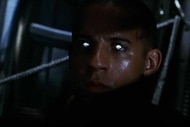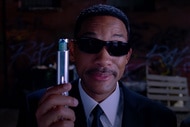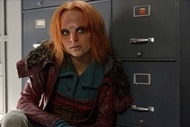How do you make a spaceship? We asked the designer of Ark One from SYFY’s new series ‘The Ark’
Going deep on what it takes to build a fully-fledged fictional spaceship.

From Pan Am’s ship on 2001: A Space Odyssey, to the Nostromo from Alien, seeing what filmmakers and designers dream up for the future of space exploration is one of the coolest things about science fiction.
But what goes into actually designing a sci-fi space ship? We caught up with production designer Randal Groves, one of the key minds behind the Ark One ship on SYFY’s new original series The Ark, to dig into the questions you have to ask when trying to keep some fictional astronauts alive a century into the future.
Groves said he took the task incredibly seriously, as the practicality, feasibility and laws of physics are all driven by actual science, and they tried to get things scientifically accurate with the series. After all, it’s only fiction until we eventually figure out the science to make it happen.
“We want to get things scientifically correct in the art department. I know it drives people crazy when they watch TV and movies and we butcher reality, because I’m one of them,” he said. “We strive to not abuse our artistic license, however the constraints of time, money and story sometimes force scientific-minded, well-meaning art departments to use the license at times. [The Ark producer] Dean Devlin once told me, ’Never let the truth get in the way of a good story.’ That said, we did try to adhere to science that is in development now and should bare fruit in the future.”
To that end, they thought through things like the artificial gravity on the Ark ship, as Groves said they made a pointed effort to show centrifugal force being used in sections of the ship to achieve artificial gravity. But of course, this being a TV show, he noted they “do take some leaps of imagination and faith on the Ark, just because it’s so hard to achieve weightlessness on a practical production level.”
They also thought through the ship’s power needs, and tried to lean on existing and cutting-edge technology like nuclear, ion and solar that could potentially power the space travel tech of the future.
“The propulsion system is an ion thruster powered by electricity derived from nuclear and solar, which is current technology that many believe will become the engine of future long distance space travel,” he explained. “The deployable solar sails that unfold like origami from the hull will collect solar energy stored in batteries but will also enable the Ark to ride solar winds when conditions allow.”
They also tried to frame the show’s storyline around the challenges real-life space explorers would face in a crisis, with life support, food, water and oxygen core elements of the story. Viewers have already had a chance to see that in action, with the crew forced to ration food and get creative in trying to grow crops and replenish water on board.
Threading the ‘Star Wars’ & ‘Space X’ vibe
So what did the design team look at to draw inspiration for the ship, tech and space suit designs? Groves said they went deep looking at films like Star Wars, Silent Running and The Black Hole for a vibe check on what this future world might look like. He said they also aimed to mix the “clean aesthetic” of Space X’s ships and gear, along with marine design cues.
Figuring out the design details down to the tiniest degree also helped the production crew repurpose spaces and sets to reuse limited resources to create various sets and locations to make the ship feel a whole lot bigger than the actual shooting real estate might suggest. To that end, things like the Ark’s hallways and modular sections could be easily reconfigured to match whatever ship geography needed to fit a scene’s needs. The large, geodesic dome set used for the bio-shelter was so big it had to be assembled outside the sets in the back lot, due to a lack of space for such a massive space on stage.
“Time, money and spacial constraints in episodic television isn’t a new challenge, and The Ark faced them like most other shows. We only had two sound stages just outside of Belgrade, Serbia (where the series was filmed) with an incredible amount of space ship that just wouldn't always fit,” he said. “Most sets were designed with a second, third and fourth use in mind.”
One of Groves’ favorite design cues in the ship comes later on in the season, when the Ark One deploys its epic solar sails. He said the design team looked to the ancient Chinese junk ship design, which featured massive sails, to help nail the look that could carry the Ark through deep space.
“I love the metallic gold material reflecting the glow of the nearest sun,” he explained. “We tried a number of sizes and configurations but kept coming back to the junk shape because it worked best in the modeling and engineering. Plus it just looks cool.”
Making it work for TV
Sketching up a spaceship on paper, or in 3D modeling, is one thing — but figuring out how to turn it into something practical that a director and film crew can make look cool on-screen is a whole different challenge. Thankfully, Groves and his crew brought more than three decades of experience to the task of bringing the Ark One to life.
“I refer to it as ‘smart design,’ this is the result of expert communication, precise interpretation of the written word, capturing the mood and tone of the material. Absorbing the director’s vision and presenting thoughtful inspiration boards in a hard format along with detailed, plot-realistic pre-visualizations. This approach makes clear for the director and production what the finished product will look like long before a dollar has been spent,” Groves said. “Designers are limited by many constrains, and this can be looked upon as a disadvantage, but I choose to see this as an opportunity. A practical working space craft would be claustrophobic and not particularly film friendly, so we often cheat the scale a bit larger to allow for crew, lighting and cameras. We also are dealing with a series that takes place entirely on stage, so we had a limited amount of stage space requiring sets to have multiple uses.”
Design was only one part of the puzzle, though, and Groves said he worked closely with the director of photography and costume designer to nail down a unified color scheme that would not only match with the design, but also pop on-screen and work together to form a cohesive vision for the world they’re building.
“We all worked closely together, sampling different color and lighting combinations with the actual cameras and lenses that would be used during the shoot. [Director of Photography] Igor Sunter is an incredible artist with a vision that pushes everyone on the crew to aspire to greatness. You want to give him as many tools as possible to let his imagination free to compose the best image possible for every frame,” Groves said. “Costume Designer Ivana Vasic is also incredibly talented, and we worked together to find the exact colors, texture and finish to compliment the costumes and production design. The Ark exists in a very monochromatic palette by design, so we tried to provide a sense of a realism and practicality that is also esthetically pleasing on camera.”
New episodes of The Ark air Wednesdays at 10 p.m. ET on SYFY, and stream next-day on Peacock.





































